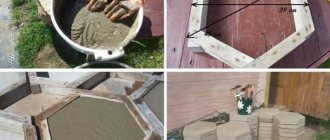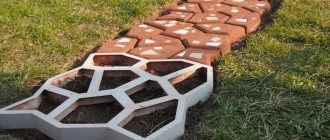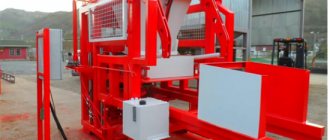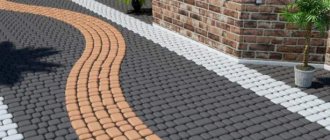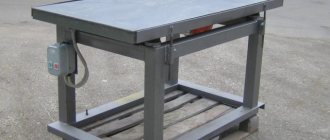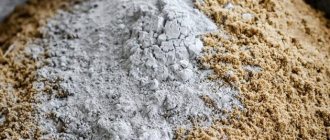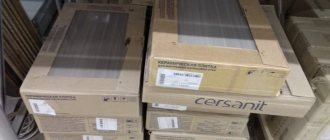What is a professional machine?
The standard device looks like a complex installation. Despite its modest dimensions, it is used to organize not only the production of street tiles, but also to establish mass production, that is, to open their own business. In the second case, it is more advisable to buy a ready-made device. This machine has five main parts:
- matrix;
- platform;
- container for solution;
- vibration installation;
- press.
The operating principle is organized as follows:
- The mixture is placed in the tank. It moves to the forms and concrete is fed through the bottom into the matrices.
- After this, plates are placed on top and the mass is pressed to the platform.
- For better compaction and removal of voids, vibration is applied. The vibrations combined with high pressure instantly compact the solution.
- Afterwards, the forms are raised, and the finished elements remain on the platform.
- Next, they are taken away along with the stand and dried.
A professional machine designed for the production of durable outdoor tiles in large quantities
A similar design can be made with your own hands, however, its power will be significantly less compared to professional equipment.
Components of a brick making machine
Let's consider the design and components of a mini-vibrocompression machine, which can be manufactured at home.
The design of the brick making press includes:
- Table.
- Tabletop.
- Vibrating device.
- Pressing device.
Diagram of a vibrating table and sand sifter
Each of these parts consists of several units and is connected with other parts structurally and technologically. Before starting work, it is necessary to complete working drawings of the device, which will allow you to determine the design of the homemade press, the list of materials and the need for them.
Let's consider the possibility of making components with our own hands, as well as the advisability of using ready-made units manufactured in industrial conditions in critical places. Due to the loads experienced by a concrete block press during operation, a home-made press machine is made of steel blanks fastened together by electric welding, which ensures a rigid connection of the press parts and almost does not respond to vibration.
Equipment for home production
To make high-quality paving slabs yourself, you need to prepare the appropriate equipment. Otherwise, you will not achieve the ideal state of concrete after pouring into the matrices.
The following devices are used in the production of standard products:
- vibrating table;
- pressing machine;
- polyurethane molds for filling.
The vibration table can be upgraded and equipped with a pressure plate.
High-quality facing material is produced using a vibrating table
A person without design experience is unlikely to produce such equipment without errors, but it’s still worth a try.
How to make a vibration pressing machine
The simplest option is to make a vibrating table. To construct such equipment, you will need:
- welding machine;
- Bulgarian;
- drill;
- mounting bolts.
The drawings are carefully worked out in advance to calculate the optimal position of the engine under the tabletop. Then a frame of 50x50 mm corners is welded and fixed on legs with plates at the lower end. They are useful to fix the installation in one place. Next, strong metal springs are fixed in the corners and in the middle. A flat tabletop with sides is installed on them. A motor, for example from a washing machine, is screwed onto the bottom.
Scheme of a homemade vibrating table
To set up the press, an additional panel in the form of a flat cover is fixed to the vibrating table, and a lot of pressure is applied to it. Separate elements are used, which are slightly smaller in size than the molds and fit into them to press the solution.
If you rely on a production sample of the machine, you will need sheet metal and a profile. The frame is welded from the latter. The container with the solution should have the shape of a trapezoid, tapering downwards. The bottom is hinged and ensures the supply of the mixture into the matrices, which are formwork made of metal and wooden planks. A sliding press is made on top from plates that fit into the shape of the clamping mechanism. Vibration is added to ensure air release. This option is applicable in the production of ordinary rectangular tiles.
It’s not easy to assemble a complete installation yourself, but it’s possible
Making a table top for a brick making machine
The tabletop of a machine for the production of concrete tile coverings (paving stones, paving slabs) must be strong and rigid. Its frame is made of perimeter parts and transverse struts.
The frame itself with spacers is made of channel No. 8-10 or angle steel 7x7 centimeters. The shape and size of the frame must correspond exactly to the shape and dimensions of the table frame; the tabletop can be the same or 6-7 centimeters larger.
After cutting with a grinder and trimming, all workpieces are laid on a horizontal plane, welded using electric welding, and then the seams are processed by grinding. During the work process, it is imperative to ensure the evenness of all parts. The working position of the frame is as follows: all horizontal shelves of the channel or corner are on top.
Next, you need to cut a rectangle in accordance with the dimensions of the frame (for this it is better to use sheet steel about 8-10 millimeters thick). The rectangle is placed on top of the frame and carefully electric welded from below. The working position of the tabletop is with the steel sheet facing up.
How to make forms
If you want to make shaped street tiles, you will need molds for pouring the mortar. You can make them yourself. You will need polyurethane with a hardener and a sample tile or a homemade element. It is made of gypsum - the best option for creating figures of any complexity and configuration. The volumetric element is filled with liquid polyurethane. Since it is mixed with a hardener, after a while a soft but solid product will be obtained, which can be removed from the workpiece after complete drying.
Polyurethane imprints every bend, indentation or protrusion of the matrix, so select only reference samples as a template.
To ensure sufficient production volumes, you will need at least 10 molds.
It is better to buy ready-made polyurethane matrices for the solution
Production recommendations
To fully produce paving slabs, it is not enough to simply purchase the necessary equipment; it is important to follow the technology and take into account all the key points associated with this process:
- A machine with a press must apply uniform, equal pressure to each centimeter of the solution.
- Strong vibration violates the integrity of the mass and breaks the tile.
- In the preparation of concrete, crushed stone and plasticizers are used, which increase the strength and elasticity of the solution.
- The grade of cement should not be lower than M500.
- Before using the tiles, the workpieces are completely dried, this usually takes at least a day. To speed up the process, special dryers are used.
- It is important to maintain optimal tile storage conditions in the production area: humidity, temperature, dust level, etc.
- The equipment is regularly cleaned and checked for proper functioning.
- When planning mass production of products, you will need to prepare an area for storing products.
If you want to start a business producing paving slabs at home, it is better to purchase factory equipment. But for personal needs, a do-it-yourself machine is a completely suitable replacement.
DIY vibration table for paving slabs: rules for assembling the structure
After all the necessary materials have been purchased, all that remains is to assemble the structure together. But in order for the resulting device to serve properly for many years, you must adhere to the following rules:
- All metal elements must be exposed to an anti-corrosion compound before assembly begins. This will provide them with reliable protection against rust. Primer GF-021 Lakra, which costs only 125 rubles/kg, or enamel paint is perfect for this purpose. At the same time, if you have to deal with elements that have already undergone corrosive processes, you will have to purchase a more expensive material, for example, EP-0180 primer, costing 188 rubles / kg.
- To fasten the components of the vibrating table, it is necessary to use a weld. Bolts are not used for this purpose because over time, as a result of exposure to vibration, they can become loose, which will lead to a decrease in the rigidity of the support. This solution is allowed only for collapsible structures, but in this case it is necessary to regularly tighten the bolts.
- It is very important that the motor that produces vibration does not come into contact with the ground under any circumstances. The technology for producing paving slabs does not allow this, and therefore, before starting the production of the first batch, the device must be tested by starting it up and checking the amplitude of oscillations and the stiffness of the springs.
- All support legs must be the same length. However, in order for the table to be convenient to use, you also need to make sure that the surface on which it will be installed is level. This will allow you to avoid distortions and make the process of making paving slabs for your dacha as efficient as possible. It is wise to think about attaching the table to the surface. This can be done using suitable anchors or concrete mortar.
The design of the vibrating table can be collapsible or stationary
Helpful advice! In some cases, the ideal location of the engine can be determined solely by experience. If there is something that doesn’t suit you about the operation of the brick making machine, you can experiment a little to achieve the desired effect and ease of use.
Methods for unbalancing a vibrating table motor
Depending on where exactly the engine is installed, it is necessary to unbalance the belt drive unit on the table top or the pulley. You can do this in several ways:
- place a round pulley on the shaft, which has a section of its circumference drilled or ground off;
- experimentally select a nut of suitable size and weight and weld it onto the pulley;
- put the coupling on the shaft, having previously welded a bolt with two nuts placed transversely onto its end. Due to the fact that the nuts can be moved along the thread, unbalancing occurs.
For reliable long-term operation of the vibrating table, it is worth using steel elements and a cooking apparatus for fastenings
As you can see, making paving slabs for your dacha yourself is a completely feasible task if you spend time and effort studying the issue and assembling the necessary device. Although it should be noted that with the help of such a vibrating table it is possible to organize, for example, a small production of polymer-sand paving slabs.

